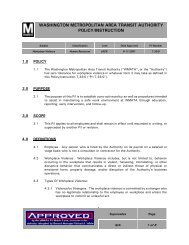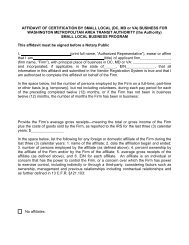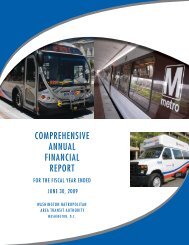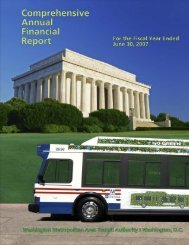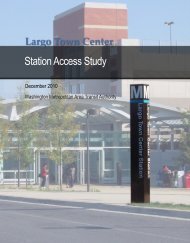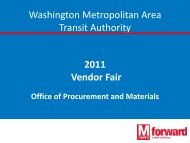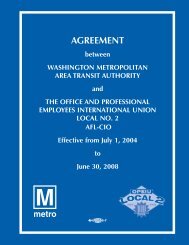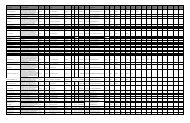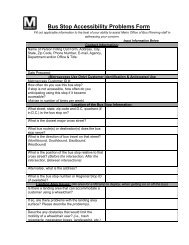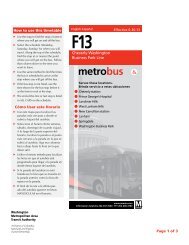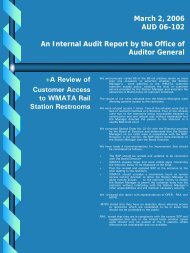Naylor Road Metro Station Area Access and Capacity - WMATA.com.
Naylor Road Metro Station Area Access and Capacity - WMATA.com.
Naylor Road Metro Station Area Access and Capacity - WMATA.com.
You also want an ePaper? Increase the reach of your titles
YUMPU automatically turns print PDFs into web optimized ePapers that Google loves.
Park & Ride<br />
Re<strong>com</strong>mendations relating to <strong>Naylor</strong> <strong>Road</strong> <strong>Station</strong>’s Park & Ride lot are dependent upon<br />
implementation of TOD <strong>and</strong> therefore summarized in the following section. No changes are<br />
re<strong>com</strong>mended to existing Park & Ride operations.<br />
TOD-Based Re<strong>com</strong>mendations<br />
In order for the established vision of TOD at <strong>Naylor</strong> <strong>Road</strong> to be realized, the current station<br />
area footprint—<strong>com</strong>prised of separate bus, Kiss & Ride, <strong>and</strong> Park & Ride facilities—must be<br />
reconfigured to create more developable l<strong>and</strong>. Dem<strong>and</strong> for Park & Ride <strong>and</strong> bus facilities,<br />
however, is estimated to increase in the future. Balancing the vision for a redeveloped station<br />
<strong>and</strong> the need to meet growing access dem<strong>and</strong> will require a variety of strategies.<br />
This study identifies future access <strong>and</strong> capacity needs at <strong>Naylor</strong> <strong>Road</strong> <strong>Station</strong>, but does not<br />
design a site plan for redevelopment of <strong>Metro</strong> property. Future station access needs in this report<br />
will provide context to future planning that will determine the character <strong>and</strong> layout of station<br />
area redevelopment. Exactly what the future station area will look like is presently unknown,<br />
<strong>and</strong> will be largely dependent on future agreements between <strong>Metro</strong>, Prince George’s County, the<br />
State of Maryl<strong>and</strong>, <strong>and</strong> developers seeking to undertake redevelopment of the site. Given this<br />
uncertainty, this section proposes a variety of strategies, which are individual re<strong>com</strong>mendations<br />
tied to <strong>and</strong> made necessary by transit-oriented redevelopment of the station area. Options<br />
are groups of strategies designed to ac<strong>com</strong>modate the access needs of <strong>Naylor</strong> <strong>Road</strong> <strong>Station</strong> in<br />
2040. While joint development is expected to begin before 2040, station facilities will need to be<br />
designed to ac<strong>com</strong>modate ridership needs over the next several decades.<br />
The options presented here have been grouped into those that achieve access goals by A) shifting<br />
parking from the station to other locations, B) replacing the station’s parking facilities on-site, or<br />
C) exp<strong>and</strong>ing the parking facilities of the southern Green Line. Kiss & Ride access would remain<br />
at the station under all options. Options are centered on parking because it is a central driver of<br />
transit system accessibility, <strong>and</strong> because its availability is among the most important aspects of<br />
successful TOD. While dem<strong>and</strong> for parking is high at <strong>Naylor</strong> <strong>Road</strong> <strong>Station</strong> <strong>and</strong> will continue to<br />
grow in the future, devoting too much space for parking can negatively impact the pedestrian<strong>and</strong><br />
transit-friendly environment of TOD as well as reduce the amount of developable l<strong>and</strong>. A<br />
balance must be struck to meet station access needs without <strong>com</strong>promising TOD placemaking<br />
principles. Presenting a variety of options provides different means of achieving this desired<br />
balance in the future.<br />
Assumptions<br />
Strategies <strong>and</strong> options in this section are based on a set of assumptions regarding future<br />
development characteristics <strong>and</strong> future transportation connectivity <strong>and</strong> accessibility. The<br />
following assumptions are <strong>com</strong>posed of factors, constraints, <strong>and</strong> considerations that influenced<br />
the development of TOD-based strategies for <strong>Naylor</strong> <strong>Road</strong> <strong>Station</strong>.<br />
1. <strong>Naylor</strong> <strong>Road</strong> <strong>Station</strong> will be redeveloped into a regional center in <strong>com</strong>pliance with the<br />
Branch Avenue Sector Plan’s approved M-X-T zone, which permits high-density, mixed-use<br />
buildings up to 12 stories high. The tallest buildings would be located the closest to the<br />
station entrance.<br />
59 | <strong>Station</strong> Re<strong>com</strong>mendations





